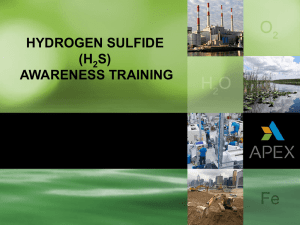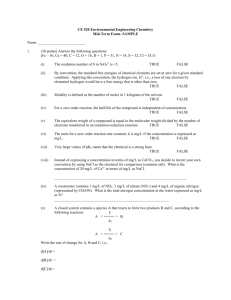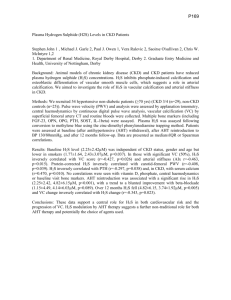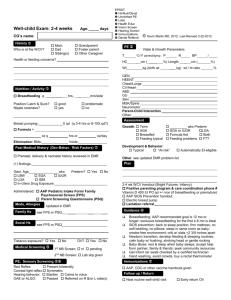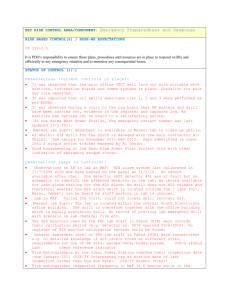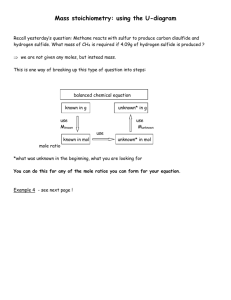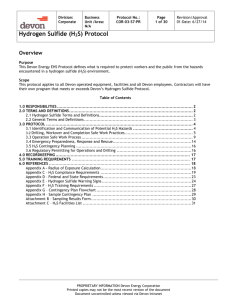H2S Safety Guideline - Southwestern Electrical Co
advertisement
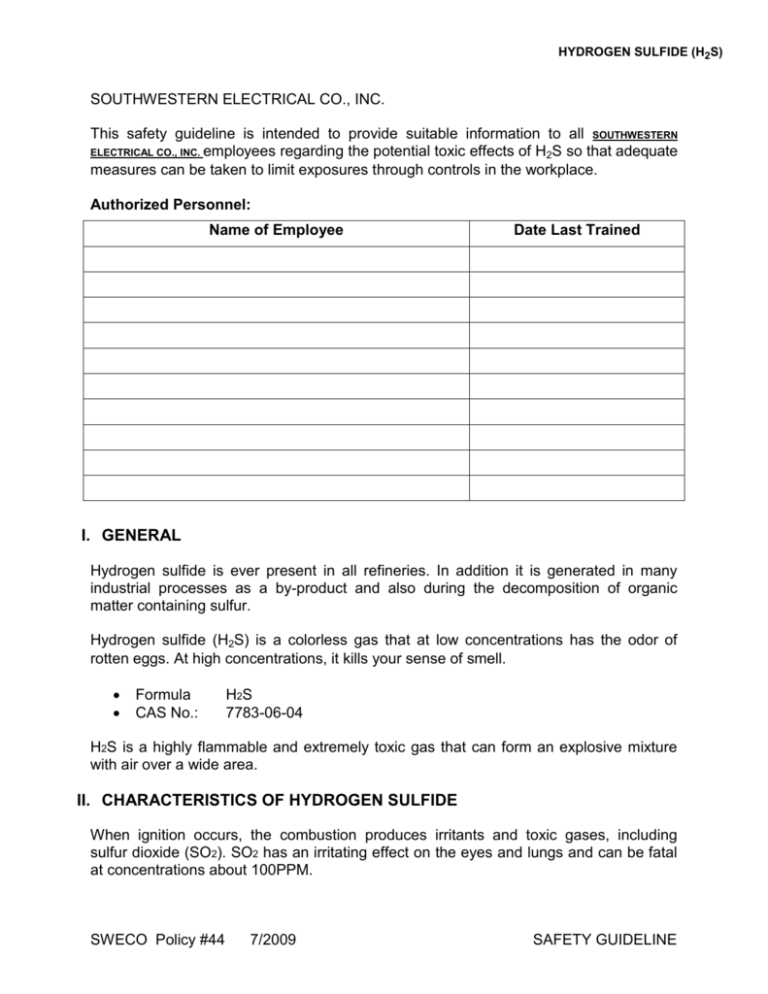
HYDROGEN SULFIDE (H2S) SOUTHWESTERN ELECTRICAL CO., INC. This safety guideline is intended to provide suitable information to all SOUTHWESTERN ELECTRICAL CO., INC. employees regarding the potential toxic effects of H2S so that adequate measures can be taken to limit exposures through controls in the workplace. Authorized Personnel: Name of Employee Date Last Trained I. GENERAL Hydrogen sulfide is ever present in all refineries. In addition it is generated in many industrial processes as a by-product and also during the decomposition of organic matter containing sulfur. Hydrogen sulfide (H2S) is a colorless gas that at low concentrations has the odor of rotten eggs. At high concentrations, it kills your sense of smell. Formula CAS No.: H2S 7783-06-04 H2S is a highly flammable and extremely toxic gas that can form an explosive mixture with air over a wide area. II. CHARACTERISTICS OF HYDROGEN SULFIDE When ignition occurs, the combustion produces irritants and toxic gases, including sulfur dioxide (SO2). SO2 has an irritating effect on the eyes and lungs and can be fatal at concentrations about 100PPM. SWECO Policy #44 7/2009 SAFETY GUIDELINE HYDROGEN SULFIDE (H2S) SOUTHWESTERN ELECTRICAL CO., INC. H2S is heavier than air, has a tendency to settle in low-laying areas, and is readily dispersed by wind movements or currents. H2S attacks most metals, especially in the presence of water, forming sulfides that are usually insoluble precipitates. It is also very corrosive to plastics and tissue. H2S dissolves in water forming a weak acid (hydro sulfurous acid). H2S will be released when in water when agitated making it a dangerous hidden hazard. III. HEALTH EFFECTS: The following information outlines the symptoms of hydrogen sulfide at specific concentrations. 10 PPM (0.001% H2S) Obvious and unpleasant odor. Burning eye irritation. Permissible exposure limit is eight hours. 200 PPM (0.02% H2S) Kills smell quickly. Stings eyes and throat. Respiratory irritation. Death after one to two hours of exposure. 500 PPM (0.05% H2S) Dizziness. Breathing ceases within a few minutes. Requires prompt artificial respiration. Loss of muscle control, making self-rescue impossible. 1000 PPM (0.10% H2S) Unconsciousness at once, followed by death within minutes. IV. EXPOSURE WARNING H2S CAN PARALYZE THE SENSE OF SMELL. DO NOT USE THE SENSE OF SMELL TO DETECT H2S. V. H2S DETECTION AND ALARM SYSTEMS In most refineries emergency employee alarms are installed to meet the regulatory standards. The alarms provide warning for the necessary emergency action according SWECO Policy #44 7/2009 SAFETY GUIDELINE HYDROGEN SULFIDE (H2S) to the site emergency action plan and provide time for employees to safely escape from the workplace or the immediate area. Systems are also used on drilling locations, offshore platforms and produce H 2S, and some plants. It is not readily used on land production leases. Signs are and should be posted stating the presence of poison gas and urging caution. VI. WARNING CONDITIONS There are three conditions that you must be aware of when working around H2S. The following information identifies the level of danger and alarms associated with each condition. Condition Green Possible Danger No Alarms Condition Yellow Moderate Danger H2S to 50 PPM Intermittent Audible Alarm and Yellow Flashing Light Condition Red Extreme Danger H2S at 50 PPM or Above Continuous Audible Alarm and a Red Flashing Light VII. HYDROGEN SULFIDE DETECTION DEVICES Fixed H2S detection devices (monitor and indicator) are designed to detect H2S concentrations in air and established TWA (time weighted average) (10 PPM) and STEL (15 PPM). The alarm should be capable of being perceived above the ambient noise or light levels in the affected area. The alarm should be distinctive and recognizable as a sign to evacuate the area and to start emergency status emergency procedures. VIII. PERSONAL MONITORS Personal monitors are also available in many types. They are also designed with the employee’s safety in mind. Familiarize yourself with the equipment available at your current work assignment. SWECO Policy #44 7/2009 SAFETY GUIDELINE HYDROGEN SULFIDE (H2S) IX. PLANT MONITORS Plant monitors are available in many types and are designed with the employee’s safety in mind. Familiarize yourself with the equipment available at your current work assignment. In order to respond effectively in an emergency situation, every individual at the site should know their specific responsibilities. Whether or not an individual has an assigned duty, each individual should know what to do in the event of an emergency. X. EVACUATION Follow these procedures in the event of a hydrogen sulfide release that requires evacuation: Hold your breath and quickly leave the area containing H2S. Do not inhale. Move quickly to the upwind “Safe Breathing Area” to receive instructions. Always be conscious of the wind and constantly monitor wind direction. Wind socks and streamers show which direction the wind is blowing so that you can determine the proper safe breathing area. XI. SCBA ESCAPE When in an area, on some client’s premises, which has required you to be trained to use or wear an escape respirator such as an SCBA, put on your SCBA and help anyone who appears to be affected by the gas. Before taking off your make, ensure that the air you will breathe is safe. Always be conscious of the wind and constantly monitor wind direction. Wind socks and streamers show which direction the wind is blowing so that you can determine the proper safe breathing area. XII. EMERGENCY RESCUE AND FIRST AID WARNING To prevent risk and injury to other personnel, re-entry into an area of unknown concentration of H2S will require the use of self-contained breathing equipment and backup personnel. Wear a full rescue unit (minimum 30-minute breathing apparatus) before attempting a rescue. SWECO Policy #44 7/2009 SAFETY GUIDELINE HYDROGEN SULFIDE (H2S) Remove the victim immediately to fresh air. If breathing, maintain the victim at rest and administer respiration immediately. If the victim is not breathing, start artificial respiration immediately. Call an ambulance and get the victim medical treatment. Keep the victim lying down with a blanket or coat under the shoulders to keep airway passage open. Conserve the victim’s body heat and do not leave the victim unattended. If the eyes are affected by H2S, wash them thoroughly with clear water. For slight eye irritation, cold compresses are helpful. A victim should not return to work until authorized to do so by a physician, even if the victim has had minor exposure and has not completely lost consciousness. XIII. PPE (PERSONAL PROTECTIVE EQUIPMENT) Depending on the exposure i.e., the amount of gas in the air and the type of work, employees will be required to wear different levels of PPE. Examples of protection include: When the exposure level is near or above 10 PPM, you will be required to wear self contained fresh air gear. Wear chemical goggles or a face shield when eye contact with this material is possible. Avoid skin contact. Wear proper clothing such as impervious gloves, long sleeves, apron, and boots. XIV. VENTILATION (INDOOR) Use adequate general and local exhaust ventilation to keep atmospheric vapor concentrations below the occupational exposure limits. XV. EYEWASH AND SHOWERS Safety showers and eyewash stations must be available in the vicinity of a potential exposure to the material. Familiarize yourself with the location of these facilities before starting the job. SWECO Policy #44 7/2009 SAFETY GUIDELINE HYDROGEN SULFIDE (H2S) XVI. TRAINING All employees will be provided awareness training in this program in order to be familiar with the potential hazards and proper safe work procedures to follow if exposed to this health hazard. The training will be provided prior to working in any job with potential exposure to H2S operations. The purpose of hydrogen sulfide training is to familiarize employees with the governmental regulations affecting H2S operations. Employees will learn the necessary skills to recognize, detect, and use the proper safety equipment in the event of an H2S incident. SWECO Policy #44 7/2009 SAFETY GUIDELINE
